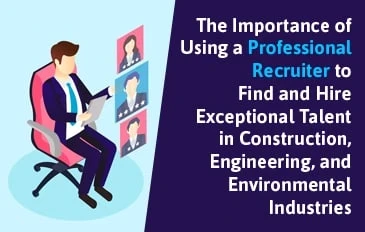The Importance of Using a Professional Recruiter to Find and Hire Exceptional Talent in Construction, Engineering, and Environmental Industries

The Importance of Using a Professional Recruiter to Find and Hire Exceptional Talent in Construction, Engineering, and Environmental Industries
In the highly competitive industries of construction, engineering, and environmental sectors, finding and hiring exceptional talent is crucial for success. However, the process of identifying and attracting top-notch candidates can be time-consuming and challenging for organizations. This is where the role of a professional recruiter becomes invaluable.
In this article, we will explore the importance of using a professional recruiter to find and hire exceptional talent in these industries. From their expertise in candidate sourcing and screening to their ability to streamline the hiring process, professional recruiters bring immense value to organizations seeking to build high-performing teams.
- Access to a Vast Network and Industry Knowledge: Professional recruiters have extensive networks and industry knowledge, allowing them to tap into a pool of qualified candidates that might not be readily available through traditional job postings. Their connections and relationships within the industry enable them to identify and reach out to top talent who may not be actively seeking new opportunities. By leveraging their network, recruiters can significantly expand the candidate search and attract highly skilled professionals who are a perfect fit for the specific requirements of the construction, engineering, and environmental industries.
- Expertise in Candidate Screening and Evaluation: Recruiters possess the skills and experience necessary to effectively screen and evaluate candidates. They thoroughly review resumes, assess qualifications, and conduct preliminary interviews to identify the most suitable candidates for the role. Recruiters are adept at identifying not only technical skills but also essential soft skills such as communication, problem-solving, and teamwork, which are crucial in these industries. Their expertise ensures that only the most qualified and competent candidates move forward in the hiring process, saving valuable time and resources for the organization.
- Streamlining the Hiring Process: Hiring exceptional talent requires a well-structured and efficient hiring process. Professional recruiters have the knowledge and tools to streamline the entire process, from creating compelling job descriptions to managing interview schedules and reference checks. They act as a liaison between the organization and the candidates, coordinating interviews, providing timely feedback, and ensuring a smooth candidate experience. By managing the logistics and administrative tasks, recruiters enable the hiring team to focus on evaluating candidates and making informed decisions.
- Confidentiality and Discretion: In certain situations, organizations may need to maintain confidentiality during the hiring process, such as when replacing a key position or expanding into new markets. Professional recruiters understand the importance of discretion and can navigate the hiring process while preserving confidentiality. They can handle sensitive information with utmost care and only disclose information to candidates on a need-to-know basis, ensuring the organization’s reputation and privacy are maintained.
- Negotiating and Securing Top Talent: Recruiters are skilled negotiators who can facilitate the offer process and secure top talent for the organization. They have a deep understanding of industry standards, compensation packages, and market trends. Recruiters can effectively communicate with candidates, address any concerns or questions, and negotiate competitive offers that align with both the candidate’s expectations and the organization’s budget. Their expertise in negotiation ensures a smooth transition from the candidate’s acceptance of the offer to their successful integration into the team.
- Time and Cost Savings: Partnering with a professional recruiter can save organizations significant time and cost in the hiring process. Recruiting professionals have the resources and tools to efficiently attract, screen, and evaluate candidates. By outsourcing the hiring process, organizations can focus on their core business activities while the recruiters handle the time-consuming tasks associated with finding exceptional talent. Additionally, the cost of a bad hire can be detrimental to an organization. Recruiters help mitigate this risk by thoroughly assessing candidates and ensuring they possess the necessary skills and cultural fit,
Michael DeSafey is a leading executive recruiter for professionals in the construction, engineering, and environmental industries. He is currently the President of Webuild Staffing: www.webuildstaffing.com. To learn more about Michael, or to follow his blog, please visit www.michaeldesafey.com.
Category: Construction, Employer Tips, Engineering, Environmental, Recruiting
How to Strengthen Your Organization By Hiring Talent

How to Strengthen Your Organization By Hiring Talent
If you are looking to hire talent that performs well in the construction or engineering industry, you want to make sure you are not limiting yourself in the way you think about recruitment. Improving your recruitment strategy can help upgrade the level of talent that you are attracting and hiring. WeBuild Staffing is considered one of the nation’s leading staffing agencies and is dedicated to scouting high quality, industry-specific technical professionals. We are committed to finding exceptional employees, and you should be too. Do you think your recruitment strategy might be flawed? Here are some Dos and Don’ts that might help you identify issues.
Don’t…
Rely Too Much On The Interview
Interviews are essential to landing a job, but they not everything. The person you are interviewing could be having a bad day or display uncharacteristic anxious. Some people will also say anything to secure a job, and great social skills and interview performance do not guarantee they are the most qualified for the job. This is especially important in the construction and engineering industries, where the new hire will be performing specific and specialized tasks.
Do…
Make sure you consider the application as a whole, taking into account the candidate’s experience and any projects they have done, without letting yourself be blinded by the way —good or bad— in which they present themselves.
Don’t…
Feel Threatened by Someone More Qualified Than You
In fear that they might jeopardize their position, managers are often hesitant to take on someone with better skills or who seem more talented. However, this person could become a vital asset and improve your company.
Do…
Look at special certifications or skills that a candidate will bring that are not already available at your company. There is no such thing as being overqualified for the job!
Don’t…
Let the Job Description Misrepresent the Job
The term itself could be misleading; a good job description is in fact more than just a description. You cannot simply offer an overview of the job, and even a long explanation might be too broad, leaving your new employees to be caught off guard by some of the duties they are asked to perform.
Do…
Include a list of duties as part of the job specifications. Make sure you indicate exactly what skills and requirements are needed to attract the right talent and discourage unqualified individuals from applying. Put yourself in the shoes of someone looking for a job: wouldn’t you want to know exactly what will be expected of you?
Don’t…
Wait For The Perfect Candidate
Most employers want to find people who check every box. However, it is time-consuming and nearly impossible to find the perfect fit for every position. The longer you wait for a candidate who is exactly what you pictured, the more you are jeopardizing your team.
Do…
Keep an open mind about what you are looking for, and consider giving a chance to someone who shows potential and is eager to grow and learn. They can end up being a valuable team member.
Don’t…
Overthink References
While references are a key part of the hiring process and give an insight into whether a candidate is a good fit for the job, they are not everything. Job seekers are very likely to have gathered their references from people they knew would give them a positive review —often close friends as well as employers— and a good experience at one company doesn’t mean it will be the same for yours.
Do…
Use references as one element for consideration in the comprehensive process of forming your own judgement about the value a candidate can bring to your company.
Michael DeSafey is a leading executive recruiter for professionals in the construction, engineering and environmental industries. He is currently the President of Webuild Staffing www.webuildstaffing.com . To learn more about Michael or to follow his blog please visit www.michaeldesafey.com
How to Hire Smart People Who Will Advise Us What to Do

How to Hire Smart People Who Will Advise Us What to Do
As a leader in the construction, engineering, or environmental space, you probably know that people are the organization’s most significant assets and capital. In essence, your hiring process could be the difference between success and failure of your company. How, then, can you hire smart people who will have the right expertise and insights to advise you on what to do? Here are essential tips that will help you get smart, proactive, and innovative staff for your firm.
Use a Talent Philosophy
When hiring, seek out individuals who are smarter, better, and more talented than you. It is also essential to look for independent-minded people who won’t fear sharing divergent opinions from yours. Avoid “yes men” employees who lack innovative ideas. The right candidate should have the knowledge and courage to identify and point out any errors you might make and suggest alternative solutions.
Keep Up to Date With Market Trends
Getting the smartest talent takes more than flipping through candidates’ resumes. Take the time to research the best-recruiting companies and the recruitment strategies they use to net highly skilled and talented employees. You also need to understand the ever-changing job market landscape. Talent keeps evolving and what worked well in the past may not be relevant for current job needs. Where possible, work with experienced recruitment agencies to help you quickly identify the best candidates. You can also ask your existing team to refer skilled candidates for consideration who fit your company’s standards.
Leverage on Social Media and Digital Trends
Social media is another great way to attract and retain the right talent. Using Facebook, LinkedIn, or Instagram appropriately, you can create a profile or embed your own digital culture site to show both what you can offer and what you are looking for in an employee. Make sure your page or website is mobile-friendly; up to 58% of potential employees use their smartphone when hunting for a job. Find out more about interesting candidates by looking at their online profiles and activities; you can mine critical data on an individual with a straightforward social media background check. Although not necessarily a decisive recruiting factor, social media activity will give you an idea of the candidate’s professional and personal interests, and make the screening process simple and effective.
Set Up a Stringent Hiring Process
However urgent your recruiting needs may be, avoid the urge to rush to hire. Use a failsafe hiring process to help you identify ideal skills and talent as quickly as possible while still being thorough. This involves formulating a comprehensive list of relevant questions and establishing a grading process that will enable a tight recruitment process. If you need help, delegate this to a solid hiring specialist or team who will shortlist candidates and conduct interviews. You can also set up a multi-tier interview process if you have a large pool of talented candidates to choose from. Finally, as a manager, hiring the ideal personnel is one of your most essential responsibilities. Look for candidates who bring in opportunities to grow your department and organization.
Michael DeSafey is a leading executive recruiter for professionals in the construction, engineering and environmental industries. He is currently the President of Webuild Staffing www.webuildstaffing.com . To learn more about Michael or to follow his blog please visit www.michaeldesafey.com
How to Streamline the Labor Hiring Process in the Construction Industry

How to Streamline the Labor Hiring Process in the Construction Industry
The U.S boasts one of the largest construction industries in the world. According to The Associated General Contractors of America (AGC), the industry creates approximately 1.3 trillion worth of structures every year. With over 7 million employees, it is one of the primary contributors of the economy. However, these figures have not stopped it from being plagued with a labor shortage.
According to a news article published by U.S News & World Report , there’s been a severe shortage of skilled labor to complete construction work. Managers were looking to fill over 225,000 construction jobs each month prior to the corona virus. What does this mean for you as a manager tasked with hiring new employees for your firm?
Labor shortages can significantly stall your projects and cost you much in losses. That’s why there’s a need to streamline the hiring process to ensure quality workers are available when needed. With this in mind, here are insights into how to improve the hiring process and counter labor shortages in construction projects..
Invest in Construction Apprenticeships
While there’s been a shortage of high-quality labor for construction work, there isn’t a shortage of young construction enthusiasts who are willing to learn. However, many companies don’t want to take this path and conduct on-the-job training. Unfortunately, if you want a constant supply of skilled, high-quality workers, you may have to invest in training.
Apprenticeships allow you to tap into the workforce pool and engage workers who either don’t have technical certificates or have less than two years experience. During training, the workers get hands-on skills while growing their expertise and knowledge in specific areas. Some of the things you offer training on include the following:
- The various codes in the construction industry
- How to use various tools and equipment
- Safety rules, regulations, and procedures
- How to work in a team
- Communication skills
Workers who successfully complete the apprenticeships and perform exceptionally can be absorbed into the team as full-time or part-time employees.
Consider Hiring Subcontractors
The labor shortage can make it hard for you to find full-time or even part-time workers for your projects. In this case, it is a good idea to engage more subcontractors instead of opting for full-time employees. As a construction manager, the subcontractors report to you and not to your company. Also, they are responsible for their work.
One benefit of using subcontractors is that they come with their own skilled and semi-skilled workers. Thus, if the subcontractor is another company, they have workers to handle the work you’ve assigned to them. Besides saving you from a labor shortage, they also cater to their own benefits and insurance needs. The only downside is it may cost you more to hire a subcontractor than it would an employee.
Embrace Construction Technology
In today’s world where the young workforce is made up of millennials, you cannot ignore the power of this generation over the construction industry. Millennials are tech-savvy individuals who are looking for opportunities that incorporate what they know best — the use of technology. Thus, by embracing construction tech in your company, you can appeal to this generation and find quality labor for your projects.
It could be simple techs such as productivity tools for workers to sophisticated ones like drone technology, artificial intelligence, virtual reality, and 3D printing. Highlight the use of these technologies in your company profile and job offers to attract millennial talent. Besides getting the young workforce interested in your company, construction technology can go a long way in improving efficiency, cutting costs, and boosting the overall profitability of the company.
Streamline Your Hiring Process for Improved Productivity
Finding the right talent to join your construction team can be an uphill task amidst the current labor shortages. However, as a smart construction manager, you can leverage these insights and snatch the best talent from the already-strained pool of workers.
Are you unable to locate the best workers for your projects? At Webuild Staffing, we pride ourselves in offering the best recruitment services for your construction company. Contact us today for more details!
Michael DeSafey is a leading executive recruiter for professionals in the construction, engineering and environmental industries. He is currently the President of Webuild Staffing www.webuildstaffing.com . To learn more about Michael or to follow his blog please visit www.michaeldesafey.com
Category: Employer Tips, Recruiting
Reaching Qualified Applicants in the Construction

Reaching Qualified Applicants in the Construction and Engineering Industry
Finding the right individual to fill a role in any industry can seem overwhelming, to say the least. It can take months of receiving and reviewing applications, interviewing potential employees, and posting advertisements online to find the candidates that best fit the role your company needs to be filled. When working in an industry such as construction or engineering, which require specific skill sets and methodologies, it can be more difficult. However, one of the most important aspects of attracting the most qualified applicants is in the way you create your job postings and advertisement
There are a variety of ways to approach advertising jobs within your company – and finding someone who will fit the expectations of your career path is one of the most important things you can to do ensure your company’s success. Below, we review a variety of important methods to successfully drawing in the most qualified applicants for all positions within your company.
Rethink Where You Post Job Opportunities
Culturally, we have moved to the age of the internet. In fact, there are entire websites dedicated to finding positions in specific industries, based on individual interest. Gone are the days in which individuals applied in person for positions. Instead, many individuals will look online for job postings. The medium through which an individual sees the job posting is going to be one of the most important factors, at the end of the day, to find your ideal applicants.
Furthermore, attending job fairs is another way to find applicants. Career-specific job fairs, like those that are often hosted at colleges, are a great way to find applicants who are new to the field and looking for opportunities. Additionally, job fairs provide both you, as the employer, with an idea of the employee pool, and provide applicants with the ability to develop an initial impression – and therefore, potential interest – of your company.
Do Away with Deal Breakers
Often, one of the things that will drive potential employees away from jobs are the deal breaker requirements. We all understand, there are certain positions that require certain skill sets. However, demanding that an employee have at least 5 years of experience as a high-level engineer with a masters degree in mechanical engineering may drive away potential employees who are highly skilled. Therefore, it is important to consider what your absolute necessities are – provide that in the description of your job posting.
Limiting your requirements will bring in more applicants who are genuinely skilled in the field. Often, individuals will not apply for a position whose job description makes them feel unqualified to do the work. Therefore, listing what is a requirement, and what may be “preferred” will encourage potentially excellent employees to apply for positions that they may not have otherwise applied for.
Think of the Posting from an Applicant’s Vantage Point
Putting yourself in some else’s shoes can be difficult, to say the least. However, it can be one of the most beneficial things you can do for your company to ensure qualified, skilled applicants are applying to your positions. When reading a job description, many individuals will look first at the requirements of the job, and then read the description. If they feel that they meet the requirements, they will review the expectations and duties of the role.
This is where you should consider the audience, you’re attempting to attract with your job postings. For instance, jobs whose description dictate that employees may receive little to no time off initially are less likely to attract potential employees, especially in the day and age in which individuals are looking for more personal freedom from work. Furthermore, having bleak job descriptions that make the work sound tedious will reduce the overall number of applicants you receive for the role.
Be Welcoming!
This is, in many cases, one of the most important aspects of creating successful job postings. With the new job force graduating college and developing career paths, in many cases, these new employees are looking for a job environment in which they feel appreciated. Presenting your company as one that wants to include and welcome employees will encourage individuals to apply, and often bring in talented employees.
Ultimately, the best way to find qualified individuals to fill roles in fields as demanding as engineer and construction career paths is to consider the expectations of the roles you are posting. Provide warm, welcoming introductions to these roles, and consider the development of the workforce presently. Combining these factors together, you will have far more success in recruiting individuals who are talented and prepared to take on the task at hand, ultimately improving your workplace.
Michael DeSafey is a leading executive recruiter for professionals in the construction, engineering and environmental industries. He is currently the President of Webuild Staffing www.webuildstaffing.com . To learn more about Michael or to follow his blog please visit www.michaeldesafey.com
